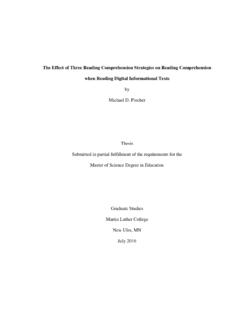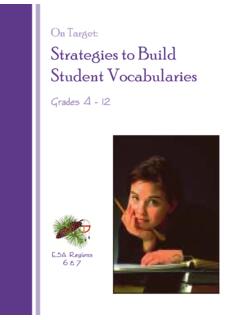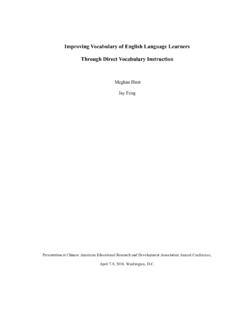Transcription of Essential Strategies for Teaching Vocabulary
1 83A Brief Overview Of Vocabulary DevelOpmentThe term Vocabulary has a range of meanings. For example, some teachers use the term to mean sight-word vocabularies, referring to students immediate recognition of words in print; other teachers refer to words students understand as their meaning vocabular-ies. Still other teachers use the term to mean listening vocabularies, or students under-standing of words that they hear in the spoken language. Content teachers use the term academic Vocabulary to refer to content-specific words. Within this section, we use the term Vocabulary to refer to students understanding of oral and print words. Vocabularies include conceptual knowledge of words that goes well beyond a simple dictionary defi-nition. Students Vocabulary knowledge is a building process that occurs over time as they make connections to other words, learn examples and nonexamples of the word and related words, and use the word accurately within the context of the sentence (Snow, Griffin, & Burns, 2005).
2 Why is Vocabulary development such an important aspect of a student s academic life? Think about the relationship of Vocabulary to overall literacy development. A num-ber of studies have shown that Vocabulary size in young children is a strong predictor for success in later grades: The larger the children s vocabularies in the primary grades, the greater their academic achievement in the upper grades. The National reading Panel (NRP; National Institute of Child Health and Human Development, 2000) analyzed scientific studies that led them to conclude that readers Vocabulary is strongly related to their understanding of text. The NRP explained that when students are taught key words before reading text, they have greater comprehension than students who do not receive such instruction. Clearly, the preponderance of such evidence led the NRP to emphasize Vocabulary instruction as an Essential element of the literacy Strategies for Teaching VocabularyIVSECTION84 Pr o m o t i n g Li t e r a c y De v eL o P m e n tReflecting on the nature of children s learning of words confirms the strong relation-ship between Vocabulary and comprehension and calls attention to the prominent place that Vocabulary instruction should hold in the literacy program.
3 Research related to Vocabulary instruction and word knowledge shows that there is a robust correlation between knowing words and comprehending text (Beck, McKeown, & Kucan, 2008). Many educators feel that a strong Vocabulary program just makes sense. Consider that words are labels for their meanings and when we know a word, we know what it rep-resents. Some words are more complex than others, having multiple meanings, while others are conceptually rich and networked to countless other words. There are those words that may have different syntactic uses depending on their context within a sen-tence. For example, the word run can be used as a noun or a verb. Thus, learning a new word takes place over time. As students hear and read the word in many different con-texts, their understanding and use of the word will develop and increase.
4 Thus, the students within our classroom may have an understanding of a word, but the degree to which they know a word may differ. The Partnership for reading (2003) has used the following three levels to describe students knowledge for word meanings: Unknown: The word is completely unfamiliar and its meaning is unknown. Acquainted: The word is somewhat familiar; the student has some idea of its basic meaning . Established: The word is very familiar; the student can immediately recognize its meaning and use the word correctly. (p. 43)GuiDelines fOr Teaching vOcABulAryLearning words does not occur in a vacuum; that is, children do not acquire meanings of words in isolation. All learning both personal and academic occurs within the socio-cultural environment of the home, community, and classroom. Literacy is a social prac-tice, so students learn academic Vocabulary through social interactions as members of the learning community (Scott, Nagy, & Flinspach, 2008, p.)
5 197). Therefore, effective teach-ers of language and literacy provide practices that stimulate rich uses of language, design-ing their instructional programs within a social context that promotes literacy know that students who are learning to read and write and those who are read-ing to learn that is, learning in content areas will benefit from a sound instructional Vocabulary program. This is especially true for classrooms where children have small vocabularies and are English language learners. Knowledge of words is acquired inciden-tally, where Vocabulary is developed through immersion in language activities. Words are also learned through direct instruction, where students learn words through a structured approach. Thus, Vocabulary programs should be designed to support children s word learn-ing through a combination of approaches to Teaching , direct instruction, and incidental word learning.
6 Michael Graves (2006) offers a framework for successful Vocabulary pro-grams that supports effective Teaching and students development of word knowledge. The foundation of his instructional program includes a four-part approach to developing robust vocabularies: (1) Provide rich and varied language experiences, (2) teach individual words, (3) teach word-learning Strategies , and (4) foster word consciousness (pp. 4 8).Providing rich and varied language experiences: Incidental word learning takes place when teachers offer and encourage students to participate in a variety of rich language experiences that occur throughout the day and across the curriculum. Examples of such experiences that promote rich and powerful vocabularies at all grade levels include Strategy iv Essential Strategies for Teaching Vocabulary 85(1) interactive read-alouds of outstanding children s literature, (2) dialogic-based instructional activities, (3) independent reading , (4) interactive writing, and (5) creating a print-rich environment where the walls are dripping with words.
7 Teaching individual words: Although many words may be learned incidentally and vocabularies do become stronger when they are supported with a language-rich environ-ment, children benefit from systematic and direct instruction of words. The research is clear with respect to effective Teaching of words (Graves, 2006). Vocabulary instruction should (1) provide students with information that contains the context as well as the meaning of the word, (2) design instruction that engages students and allows sufficient time for word learning, (3) make sure students have multiple exposures to the words with review and practice, and (4) create a dialogue around the word-learning Strategies : An important aspect of developing students robust vocabularies is Teaching them tools to unlock the meaning of unknown words. The most effective tools use the context of the surrounding words or sentences to infer the mean-ing of a word, using meaningful word parts to make sense out of the unknown word and using the dictionary effectively to help define an unknown word consciousness in readers and writers: An important aspect of a strong Vocabulary program is to engage students in learning new words.
8 As teachers, we need to develop word consciousness within our students and maintain their interest in words. Graves and Watts-Taffe (2008) suggest that teachers (1) create a word-rich environ-ment, (2) recognize and promote adept diction, (3) promote word play, (4) foster word consciousness through writing, (5) involve students in original investigations, and (6) teach students about words (p. 186).A strAteGy fOr AssessinG Vocabulary DevelOpmentAssessing student learning is a critical component of effective Teaching and achievement. Therefore, part of the teacher s literacy instructional plan needs to include the assess-ment of students Vocabulary development. We aligned our progress monitoring of Vocabulary with the following instructional goals: (1) to enhance Vocabulary develop-ment and use, (2) to develop word-learning Strategies , and (3) to build word conscious-ness.
9 One approach in assessing students Vocabulary development is through the use of the rubric in Figure The rubric contains six criteria related to the goals of the Vocabulary instructional program. By monitoring students progress, teachers may use the results to modify their instruction to meet the needs of individual students, those of the class, and the instructional program. CriterionLevel #3 Advanced(3 Points)Level #2 Developing(2 Points)Level #1 Striving(1 Point)Word identificationThe student is proficient in saying, reading , or writing the student has some difficulty saying, reading , or writing the student has a lot of difficulty saying, reading , or writing the Rubric for Assessing Vocabulary Development(Continued)86 Pr o m o t i n g Li t e r a c y De v eL o P m e n tWord meaningThe student knows the comprehensive meaning of the word and can discuss multiple meanings of the student knows a partial meaning of the word but has difficulty discussing a full meaning of the student does not know the meaning of the word and cannot discuss the wordThe student offers a rich explanation of the contextual meaning of the student offers a partial explanation of the contextual meaning of the student is not able to explain the contextual meaning of the the wordThe student uses the word with a high degree of accuracy within the context of writing.
10 The student uses the word with some degree of accuracy within the context of student does not attempt to use the word within the context of strategiesThe student uses a range of word-learning Strategies , along with varied resources, to learn new student uses few word-learning Strategies and resources to learn new student does not use word-learning Strategies and resources to learn new consciousnessThe student demonstrates an awareness and interest in learning and using new student demonstrates a minimal awareness and interest in learning and using new student does not demonstrate an awareness and interest in learning and using new level of Vocabulary developmentAdvanced level18 13 pointsDeveloping level12 7 pointsStriving level6 0 pointsA GuiDe fOr usinG respOnse tO interventiOn fOr vOcABulAryWord knowledge is more than just reading a word! As we have discussed in this section, knowing words is multidimensional and the process occurs over time.













